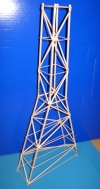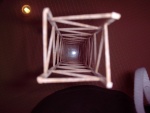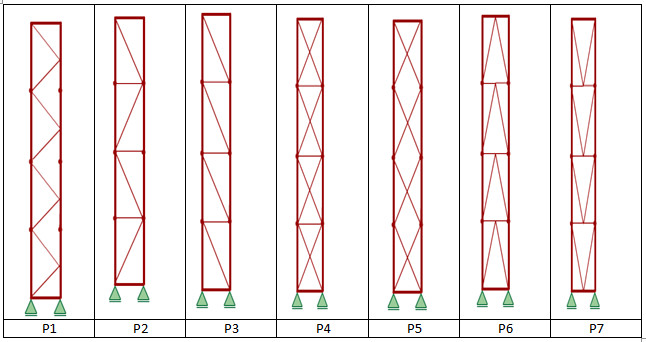Towers
| Towers | ||||||
|---|---|---|---|---|---|---|
| Type | Engineering | |||||
| Category | Build | |||||
| Event Information | ||||||
| Latest Appearance | 2018 | |||||
| Forum Threads | ||||||
| ||||||
Towers is a Division B and Division C event for the 2017 and 2018 seasons. In this event, given certain parameters of height and material, each team is to design, build and test the lightest and tallest tower to carry a maximum standard load. The tower must span an opening (in most years, a 20 cm x 20 cm square), and support a load at a minimum height.
How to Build a Tower
This section describes the process for building a tower. While the specific construction parameters change from year to year, this process generally remains the same, aside from specifics regarding the design.
The first issue of tower building is the wood selection. Many consider balsa wood to be the best, followed by bass. However, there are many different opinions on which to use. Here are some opinions:
- One opinion recommends an all balsa wood tower, but it may be pretty tricky to handle. To use any type of wood, an extremely sharp knife is needed for each cut to avoid smashing the wood fibers (A blade will have a lot of life left after you change it for tower building, and one way to save costs is to save the blades and use them later for other projects, etc.). Smashing the wood fibers damages the integrity of the wood and may result in a lower score.
- Another opinion states that heavy basswood should be used when first trying to understand the dynamics of the structure. Once a working design is completed using basswood, weight can then be removed by using smaller sizes or balsa. Using balsa can make it more difficult if it is your first time.
- Another opinion suggests a mix of balsa and bass. Bass is used where extra strength is needed. In all other places, balsa is fine. The legs are normally bass and bracings balsa. A mix of the two brings out the best of both in one tower.
Balsa vs. Bass:
- Balsa is on average lighter for a specific strength, although individual pieces vary in both woods.
- Balsa is easier to bend. This is generally not relevant in Towers, but may be important for some specialized designs.
- Bass has less variation between pieces than balsa with regard to the range of density for a certain size, and the range of strength for a specific density.
- Bass is generally stronger for a certain size, though usually heavier as well.
Step 1
- The next step is design. A four legged tower is easier to build but may not be as efficient. A 3-legged tower is extremely difficult to build, as the angles aren't nice and neat. Furthermore, a bracing strip needs to be angled 2 ways, whereas in a 4 legged design it only needs to be angled in one direction. Also, don't forget about laminating wood together- many good towers have been built by laminating very small wood together for the legs.
- Make sure to comply to the rules for dimensions. In 2018, for division B, the tower must be 50cm tall, and in division C, the tower must be 60cm tall. Also, the 2018 rules state that it must be able to pass through an 8cm diameter circle at 25cm from the ground for division B, and 20cm from the ground for division C. Therefore, a two-part design is essentially required in 2018, whereas in 2017, one-part designs were more common.
- After the number of legs is decided, the bracing is the part that towers are won and lost by. It depends on the type of leg design is used, but generally, balsa wood legs of dimensions 3/16x1/8cm need to be braced every 5 or 6cm all the way up (by the way, a solid wood square is not the best way to go for legs). Also, with the bracing, equality is of high importance. If you brace at 5cm and then the next space is 8cm, you're testing the 8cm space. It would be better to brace at 6.5 cm and 6.5 cm in this example.
- In addition, when creating a four-legged tower, there is a choice between building a rectangular base or a square base. A rectangular base tower needs stiffer legs and is lighter, but has a high chance of tipping over. A way to avoid this (though will add weight) is to slant the wide side of the tower until it almost forms a pyramid.
- It is highly advised to test, test, and test some more. The more you build, the better your chances of getting a good design, and the better you get at building. Analyze any failed structures. Knowing which member broke first (which can be determined by the type of break, sheer, torque (twisting or bending) will tell you what piece of wood needs to be denser, or larger in cross section. It is a very good idea to understand how the stresses are flowing in your tower. Eventually, time spent on building individual towers will decrease, while the quality will increase. Also, never test towers over the maximum weight that the rules say. If it holds, set it aside and see where you can cut back. If you fail, then you still have a backup.
Step 2a: Materials
Get the Following Recommended Materials:
- Easy Cutter by Midwest (Easy, fast, and clean cuts, even angled) ~$15-$20 on eBay.
- A pack of extra blades may also be useful
- 1/8 and 1/16 BalsaWood. (Make sure the 1/16 isn't too flimsy and cheap)
- Zap-A-Gap glue (reasonably strong, and fast curing)
Step 2b: Design
- So how should a tower be built? The best way is to really create a full-scale blueprint on graph paper. First of all, a more general design should be drawn out. Here is a basic design from 2006.
Once that is finished, the design should be drawn out on graph paper. It makes it a lot easier if you create a "jig" of your blueprint. In other words, use pieces of scrap wood to create a template shown below:
(picture to come)
The jig makes it possible for concise construction of the tower, ensuring it will not be slanted.
Step 2c: Bracings
Once the design of the tower fully planned out, it is time to consider what type of bracing to use.
- One idea suggests using an X Brace, where two pieces of wood cross over each other, creating an X. The advantage of this method is that it will prevent the legs from bowing outwards and slightly inwards, but at the cost of more wood.
- The second idea mentions using a Z Brace, where a diagonal piece of wood lies in between two horizontal members. The benefit to having this is that the side will be held together, but will start to torque in the direction of the diagonal brace.
- Another method is to use Z Bracings without the horizontal members, similar to this (Imagine the chimney on its side): |/\/\/\/\/\/\|. The benefit to having this is that it requires less wood and almost provides as much support as the Z Brace. However, since there is no horizontal brace to keep the tower from bowing inwards, you would need to angle the bracings at a smaller angle and have a medium-high density wood.
There are many other types of bracings, such as the V brace and the /\ brace, too. However, their scores in the previous years are not too high, so other types of bracings are much better to use.
Below are examples of what these braces would look like. Note that these are only examples of what the would look like, not how many of them you should have.
Step 3: Construction
- Construction is rather easy with an easy cutter and plans with measurements. All you have to do now is to cut all the pieces out that you have measured, although this can take up hours if you have never done it before. Remember to cut out 4x the wood on the blueprint, then connect the two halves with bracings that form the 3rd and 4th sides.
- The straightness of the tower is incredibly important. If the balance is off and the weight is not distributed equally it will fail when using lighter smaller wood.
- Create a smaller loading block support hole to avoid the loading block from slipping or falling off.
- If you haven't drawn any plans, STOP! You must go back to 2a.
Tips and Tricks
- The Test Base opening is typically a square of 20 cm sides. This means that a tower with a base of 15 or 16 cm can be oriented so that each leg rests at the midpoint of the opening's sides, rather than building a tower with a base of 20 or 21 cm with the legs resting at the corners.
- It is far more difficult to increase the size of a stick than to decrease the size. Hence, cut sticks so that there is some extra length, making it easier to adjust - if a stick is cut too short, there's no way to correct it.
- Make sure to apply only the amount of glue needed - in most cases, significantly less than one drop. Too much glue will increase the mass of the tower and it will not significantly increase the strength - in an adequately constructed tower, the glue joints are among the strongest parts. The faces being glued to each other should be as flat as possible to minimize the amount of space-filling done with glue.
- Short, light bracings are better than long, heavy bracings.
- When attaching braces, make sure to glue them on top of the frame as opposed to adjacent to the frame. It makes the tower much stronger because it provides a greater contact area.
- Remember that using too much wood will weigh down a tower and result in a lower score. Most winning towers win because of their weight, so even if a tower holds all 15 kg, the score will still be more dependent of the weight of the tower itself.
- Ideally, the load should be equally distributed across each leg of the tower. To help the tower rest on the test base more evenly, sanding the bottom of the legs can be helpful. However, be careful not to end up with a tower that is shorter than the minimum allowed height.
- Keep in mind that if a tower's base is 29 cm wide, a load score bonus of 5000g will be rewarded (2018 season). Of course, this isn't always recommended due to the risk of a lower score. If you do decide to get the bonus, remember that your tower will be weaker. It is also advised to have a base slightly bigger than the requirement to avoid risking the potential bonus and weakening your tower for nothing.
- Build on a consistent basis and test regularly.
- It is recommended to record a test with a slow motion camera. Towers typically begin failing at a single point, which cascades into a failure of other members. A slow-motion video makes it easier to identify the point of failure and fix/improve it.
- NEVER GIVE UP! Towers is a frustrating event in which many towers have to be built in order to succeed. Don't give up and keep persevering. The reward is very satisfying.
Competition
Check in
Before device testing, teams will check in to verify that the tower meets the requirements. Teams measure the tower verify that the tower is tall enough, pass an 8-cm diameter ring gauge and measure where the gauge rests, and put the tower on the scale so the supervisor can determine the mass.
Scoring
A tower is scored primarily according to its efficiency - load held mass divided by the mass of the tower. For example, a tower that weighs 5 grams and holds 15 kilograms would earn a score of [math]\displaystyle{ \frac{15,000 \textrm{ g}}{5 \textrm{ g}}=3000 }[/math]
The maximum "load held" is 15 kilograms.
In most years, there are additional factors that affect the score:
- In 2018, there is a bonus awarded if the tower spanned a 29cm circle centered on the 20cm by 20cm opening. The bonus adds 5000 grams to "mass held".
- In 2017, there was a bonus awarded if the tower spanned a 29cm circle centered on the 20cm by 20cm opening. The bonus added 2000 grams to "mass held".
- In 2012, the tower efficiency was weighted by the height of the tower. The specific weight depended on the tournament level (regional, state, national), such that at higher tournament levels a corresponding increase in height would have a greater impact on the score, encouraging taller towers at higher levels of competition.
- In 2011, the score was calculated using the square of the load held, in kilograms, divided by the mass of the tower in grams.
Teams who violate construction or competition rules (sections 3 and 4 of the rules, respectively), and teams whose towers are unable to be tested (e.g. the tower doesn't span the gap) are ranked in lower tiers.
Competitiveness of teams in Towers at different tournaments varies greatly. As of the 2017 season, in the majority of states, a score of 1000 is sufficient to finish near the top 4-6. In some larger states, high scores reach 2500+, or even 3000+. At the 2017 National Tournament, the medal-winning scores were approximately 2900-3500 in Division B, and 2700-3300 in Division C.
Useful Threads
From 2006:
- Tower Base
- Tower Help
- Glue for Towers
- Tower Bracing Help
- Tower - Straight or Curved
- Tower Efficiencies
From 2005:
From 2004:





